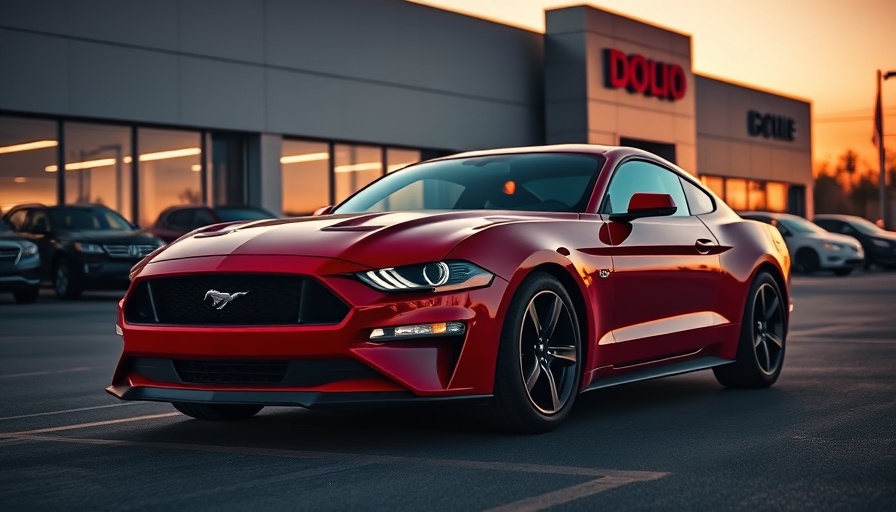
Introducing an Icon: The Birth of the Ford Mustang
Few cars have made an entrance quite like the Ford Mustang, which set an entirely new standard in the automotive world. Launched on April 17, 1964, during the New York World's Fair, the Mustang didn't just fill a gap in the automobile market; it created a distinctive segment known as the pony car. In the early 1960s, American consumers faced limited automotive choices, primarily large family sedans or compact options. The introduction of the Mustang transformed this landscape, offering a stylish, performance-oriented vehicle within a price range that appealed to many.
The Strategic Reveal: A Masterclass in Marketing
The unveiling of the Mustang was a carefully orchestrated event, taking place at Ford's Pavilion amidst the bustling crowds of the World’s Fair, which attracted over 50 million visitors. This captivated audience transformed the Mustang's debut into a media sensation, with newspapers and television coverage highlighting its innovative design and competitive pricing—under $2,400. As visitors marveled at the Mustang's sleek hardtop and convertible options, the car quickly captured the public's imagination, marking the dawn of the pony car era and setting the stage for rivals like Chevrolet and Plymouth to follow shortly.
Meeting Consumer Demand: Launch Availability
Unlike many cars of its time, which often delayed availability after their initial reveal, Ford was prepared for immediate demand. By the end of the very first day of the Mustang's introduction, over 22,000 units were ordered. Early buyers were enamored and didn't even hesitate to place orders without test-driving the vehicle. Ford’s proactive approach to production meant that they had early 1965 models ready for dealers as soon as sales began, thereby maximizing their launch impact.
Designing the Dream: The People Behind the Mustang
The introduction of the Mustang was a team effort predominantly led by key figures in Ford's history. Lee Iacocca, then Ford Division General Manager, championed the project. Donald Frey, a Chief Engineer, played a pivotal role in keeping costs low by integrating components from the more affordable Ford Falcon, while Joe Oros, the head designer, helped shape the Mustang's iconic look. This collaborative effort resulted in a car that was not only affordable but visually appealing, setting a benchmark for design excellence that continues to influence automotive design today.
Performance Options and Features that Captivated
The 1964½ Mustang came equipped with a long hood, short deck design, and a spacious interior, making it attractive to a wide range of customers. Buyers could choose from multiple engine options, ranging from a 170-cu-in inline-six to a more powerful 289-cu-in V8. These choices, combined with the option of a three-speed manual or upgraded four-speed manual transmission or Cruise-O-Matic automatic, gave customers the flexibility to tailor their vehicles according to their driving preferences. The affordability and versatility catapulted the Mustang into popular culture, establishing it as a symbol of American automotive prowess.
A Legacy That Endures
As we look back, the Ford Mustang stands as a classic symbol of not just a car but a cultural phenomenon. Its strategic launch, combined with cutting-edge design and thoughtful marketing, revolutionized the automotive industry. The Mustang has not only survived but thrived through decades, continuing its legacy as a beloved performance vehicle in both the classic car community and among modern enthusiasts.
Taking Care of an Icon: Maintenance Tips
Owning a classic Mustang, or any vintage vehicle, entails more than just enjoying its beauty and performance. It involves a commitment to maintenance that ensures its longevity. Essential car maintenance tips for classic cars include sticking to a regular vehicle maintenance checklist, monitoring tire rotation schedules, and knowing how to check transmission fluid levels. Additionally, doing routine checks on the engine and brake pads saves money on costly repairs down the road. For Mustang owners, familiarizing oneself with unique maintenance techniques specific to vintage models can provide not only peace of mind but also enhance the driving experience.
Get in Gear!
For those considering acquiring or restoring a classic Ford Mustang, now is an opportune time to dive into this thrilling venture. Embrace the experience of owning a piece of automotive history, and keep it running smoothly with informed maintenance practices. The joy and pride of driving a legendary Mustang await you, so start your journey today!
 Add Row
Add Row  Add
Add 




Write A Comment